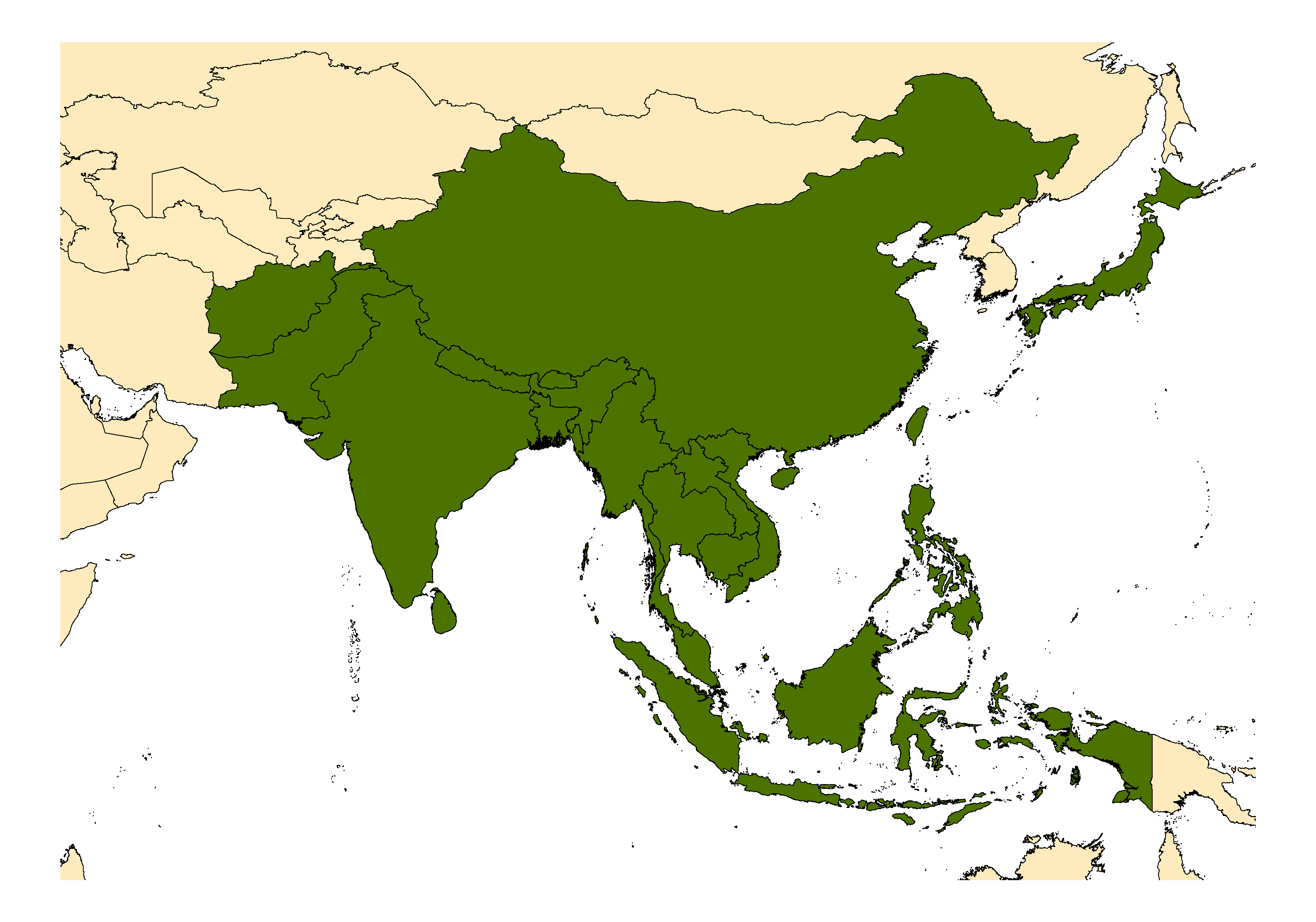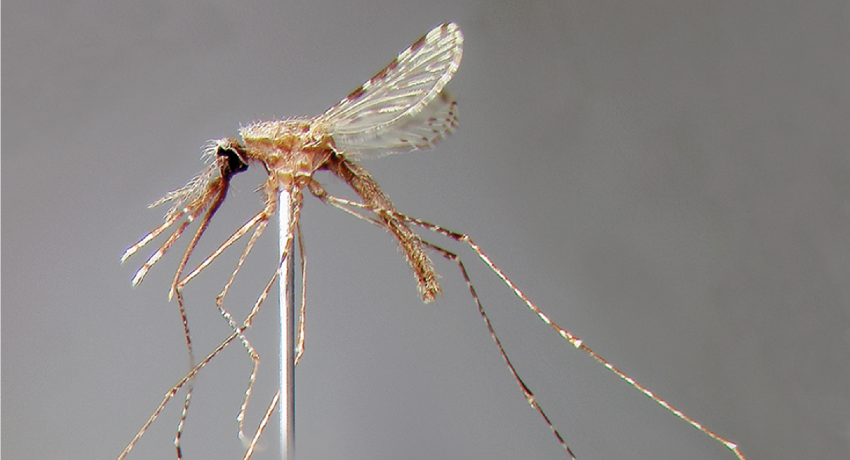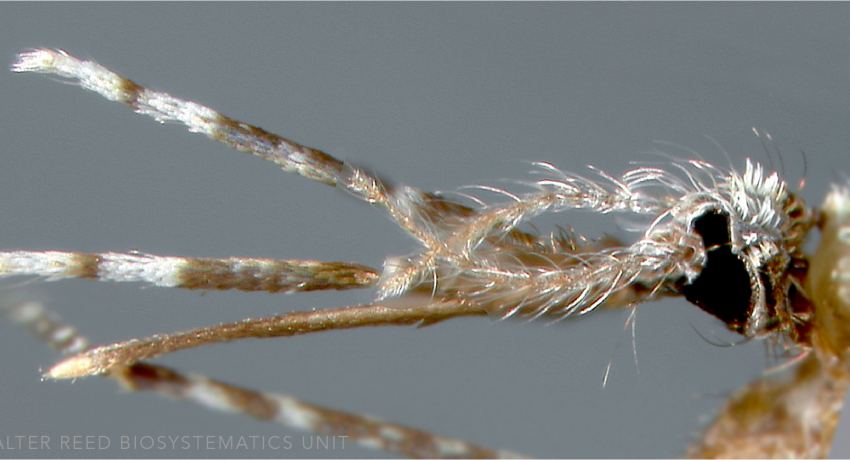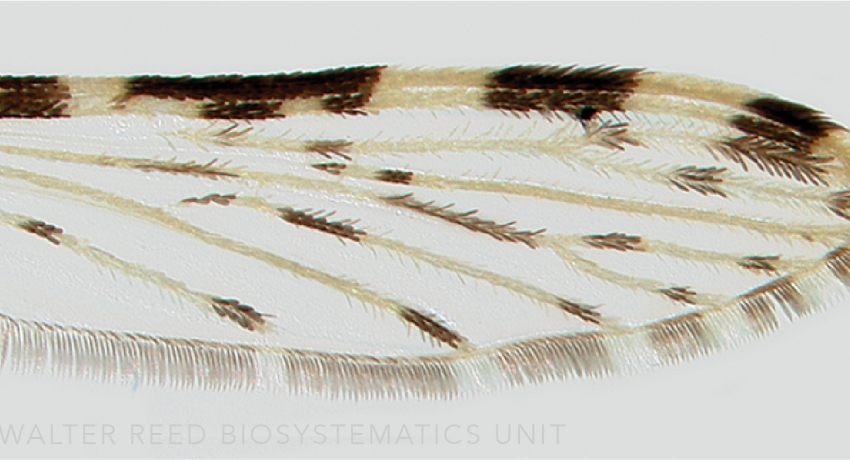INDO-ORIENTAL REGION
Etymology: spotted (L); wings
Anopheles maculatus is a small mosquito, with four distinct dark spots on the leading edge of the wing, and the remainder of the wing mainly pale-scaled. Cryptic taxa were first proposed on the basis of chromosomal differences, and nine formally described species are now recognized within the Maculatus Group—An. maculatus s.s. (= form B), An. sawadwongporni Rattanarithikul & Green (= form A), An. dravidicus Christophers (= form C), An. greeni Rattanarithikul & Harbach (= form D), An. notanandai Rattanarithikul & Green (formerly form G), An. willmori (James)(= form H), An. pseudowillmori (Theobald) (= form I), An. dispar Rattanarithikul & Harbach (= form J), and An. rampae Harbach & Somboon (= form K). Within the Maculatus Group, An. maculatus s.s. and An. dravidicus comprise the Maculatus Subgroup, and An. notanandai, An. rampae and An. sawadwongporni make up the Sawadwongporni Subgroup. All others remain unplaced. Anopheles maculatus s.s. has one synonym—hanabusai Yamada described from Taiwan.
Type locality: Hong Kong [People’s Republic of China]
Type depository: Natural History Museum, London, England, United Kingdom (NHMUK)
DIAGNOSTIC CHARACTERS (Click photos to view; mouse over and click large photo to zoom in.)
ADULT (illustrated): Thorax: Upper proepisternal setae absent. Legs: Fe-III, Ti-III and Ta-III1 speckled; Ta-III5 pale-scaled. Wings: Veins C and R–R1 with ≥4 dark spots.
LARVA (not illustrated): Head: Distance between bases of seta 2-C > distance between bases of setae 2-C and 3-C on one side; seta 1-A small, single, rarely 2,3-branched; setae 2,3-C aciculate; setae 5–7-C long, branched. Thorax: Seta 1-P with 15 branches; seta 11-P slender with fine branches. Abdominal segments: Seta 6-III usually with 20 branches; seta 6-V,VI 3–6 branched.
TAXONOMIC KEYS
Nguyen Thuong Hien 1968
Darsie & Pradhan 1990
Rattanarithikul et al. 2006b
Becker et al. 2010
![]()
WRBU – Anopheles - Neocellia Series - Indomalayan Region - Adult
![]()
WRBU – Anopheles - Neocellia Series - Indomalayan Region - Larva
![]()
WRBU – Anopheles - Neocellia Series - Oriental Region - Adult
![]()
WRBU – Anopheles - Neocellia Series - Oriental Region - Larva
![]()
WRBU - Anopheles - Western Palearctic Region - Adult
![]()
WRBU - Genera - Global - Adult
![]()
WRBU - Genera - Global - Larva
![]()
WRBU - Genera - Eastern Palearctic - Adult
![]()
WRBU - Genera - Eastern Palearctic - Larva
![]()
WRBU - Genera - Indomalaya - Adult
![]()
WRBU - Genera - Indomalaya - Larva
![]()
WRBU - Genera - Oriental - Adult
![]()
WRBU - Genera - Oriental - Larva
![]()
WRBU - Anopheles Subgenera and Series - Indomalaya - Adult
![]()
WRBU - Anopheles Subgenera and Series - Indomalaya - Larva
![]()
WRBU - Anopheles Subgenera and Series - Oriental - Adult
![]()
WRBU - Anopheles Subgenera and Series - Oriental - Larva
![]()
WRBU - Anopheles (Cel.) Neocellia Series - Australasia - Adult
![]()
WRBU - Anopheles (Cel.) Neocellia Series - Indomalaya - Adult
![]()
WRBU - Anopheles (Cel.) Neocellia Series - Indomalaya - Larva
![]()
WRBU - Anopheles (Cel.) Neocellia Series - Oriental - Adult
Exemplar DNA sequences
An. maculatus s.s. ITS2: DQ518615–19, MF535219–21
An. dispar ITS2: AF234778
An. dravidicus ITS2: JQ446414–16
An. greeni ITS2: AF234779
An. notanandai None
An. rampae ITS2: DQ518626–27, KY039086
An. pseudowillmori ITS2: DQ518628–29; JQ446421–27
An. sawadwongporni ITS2: JQ446417–20
An. willmori ITS2: JQ446411–12, AF512552
BIONOMICS
Immatures
Anopheles maculatus s.s. immatures are collected in sunlit rockpools near waterfalls, or in drying stream pools in hilly, forested areas, close to human settlements.
Adults
Anopheles maculatus is highly anthropophilic, biting both indoors and out from dusk until around 21:00. Anopheles maculatus s.s. is a primary vector in India, Java, Malaysia and Thailand. Other Maculatus Group species are also effective primary vectors—including An. sawadwongporni in Thailand, An. willmori in Nepal and An. pseudowillmori at the Myanmar-Thai border. In the Philippines, An. dispar and An. greeni are predominantly zoophilic, and secondary vectors at best. Anopheles dravidicus, An. rampae and An. notanandai are not implicated in malaria transmission.
DISTRIBUTION NOTES
Afghanistan, Bangladesh, Bhutan, Cambodia, India, Indonesia (includes Flores, Java, Kalimantan, Moluccas, Sumatra includes Ketulauan Riouw Archipelago, Sulawesi, Timor), Japan, Laos, Malaysia, Myanmar, Nepal, Pakistan, People's Republic of China (includes Hainan & Hong Kong), Philippines, Singapore, Sri Lanka, Taiwan, Thailand, Timor, Vietnam.

WRBU VECTOR HAZARD REPORTS
View other WRBU Vector Hazard Reports
Available GIS Models
An_maculatus_s.l._Foley_1 Asia
IMPORTANT REFERENCES (full citations below)
Theobald 1901a: 171 (M*, F*)
Christophers & Barraud 1931: 179 (E*)
Christophers 1933: 278 (M*, F*, L*, E; taxonomy)
Crawford 1938: 93 (P*)
Ho 1938b: 402 (M*, F*, P*)
Ross & Roberts 1943b: 33 (M*, F*, L*; taxonomy, distribution, bionomics)
Bonne-Wepster & Swellengrebel 1953: 454 (M*, F*, L*)
Hara 1959: 111 (F*)
Nguyen Thuong Hien 1968 (F*, L*; keys, taxonomy, bionomics, Vietnam)
Reid 1968: 353 (M*, F*, P*, L*, E*; taxonomy)
Aslamkhan 1971b (distribution; Pakistan)
Basio 1971b: 42 (M*, F*; bionomics)
Narang et al. 1973: 13 (chromosomes*)
Baisas 1974: 68 (M, F*, P, L*; taxonomy, bionomics, distribution; Philippines)
Green et al. 1985a (chromosomes; maculatus s.l.)
Rattanarithikul & Green 1987 (1986): 252 (lectotype designation; distribution)
Darsie & Pradhan 1990 (F, L; taxonomy, keys, bionomics, distribution; Nepal)
Suleman et al. 1993 (distribution; Pakistan)
Whelan & Hapgood 2000 (bionomics, distribution; East Timor)
Oo et al. 2004 (distribution; Myanmar)
Rattanarithikul et al. 2006b (F*, L*; bionomics, distribution, keys)
Becker et al. 2010: 345 (F*, L*; key, taxonomy, distribution, bionomics)
Sinka et al. 2011: 89 (bionomics review, distribution, niche model; Maculatus Group)
Singh et al. 2012 (molecular taxonomy; sensu lato)
Namgay et al. 2018 (distribution, bionomics; Bhutan)
CURRENT SYNONYMS
syn. hanabusai Yamada
1925: 471 (M, F; Myzomyia). Type locality: Kagi, Formosa [Taiwan, ROC] (IID). References: Ho 1938b: 402 (M*, F*, P*).
CURRENT SUBSPECIES
None
CITED REFERENCES
Aslamkhan, M. (1971b). The mosquitoes of Pakistan I. A checklist. Mosquito Systematics, 3(4), 147–159.
Baisas, F. E. (1974). The mosquito fauna of Subic Bay Naval Reservation, Republic of the Philippines. San Francisco: Headquarters, First Medical Service Wing (PACAF), San Francisco.
Barraud, P. J., & Christophers, S. R. (1931). On a collection of anopheline and culicine mosquitoes from Siam. Records of the Malaria Survey of India, 2(2), 269–285.
Basio, R. G. (1971b). The mosquito fauna of the Philippines (Diptera, Culicidae). Manila: National Museum of the Philippines. 198pp.
Becker, N., Petrić, D., Zgomba, M., Boase, C., Madon, M., Dahl, C., & Kaiser, A. (2010). Mosquitoes and their control (Second ed.). Berlin Heidelberg: Springer-Verlag.
Bonne-Wepster, J., & Swellengrebel, N.H. (1953). The anopheline mosquitoes of the Indo-Australian Region. Amsterdam: J. H. de Bussy.
Christophers, S.R. (1933). The fauna of British India, including Ceylon and Burma. Diptera.Vol. IV. Family Culicidae. Tribe Anophelini. London: Taylor and Francis.
Crawford, R. (1938). Some anopheline pupae of Malaya with a note on pupal structure. Singapore: Printed at the Government Printing Office, by W.T. Cherry, Government Printer.
Darsie, R.F., Jr., & Pradhan, S.P. (1990). The mosquitoes of Nepal: Their identification, distribution and biology. Mosquito Systematics, 22(2), 69–130.
Green, C.A., Baimai, V., Harrison, B.A., & Andre, R.G. (1985a). Cytogenetic evidence for a complex of species within the taxon Anopheles maculatus (Diptera, Culicidae). Biological Journal of the Linnean Society, 24(4), 321–328.
Hara, J. (1959). Taxonomical notes on the female terminalia of some anopheline mosquitoes of Japan and Formosa. Taxonomic and ecological studies on mosquitoes of Japan (Part 12). Japanese Journal of Experimental Medicine, 29, 107–119.
Ho, C. (1938b). On a collection of anopheline mosquitoes from the island of Hainan. Annals of Tropical Medicine & Parasitology, 32,387–411.
Namgay,R., Drukpa, T., Wangdi, T., Pemo, D., Harbach, R. E., Somboon, P. (2018). A checklist of the Anopheles mosquito species (Diptera: Culicidae) in Bhutan. Acta Tropica 188 (2018) 206–212.
Narang, N., Narang, S., Kitzmiller, J.B., Sharma, G. P., & Sharma, O. P. (1973). Evolutionary changes in the banding patterns of salivary gland chromosomes in the genus Anopheles, subgenus Cellia. Journal of Medical Entomology, 10, 13–22.
Nguyen Thuong Hien 1968. The genus of Anopheles in Vietnam. Saigon: Bureau of Entomology, National Malaria Program/ Republic of Vietnam. English translation by Military Entomology Information Service. 205pp.
Oo, T.T., Storch, V., & Becker, N. (2004). Review of the Anopheles mosquitoes of Myanmar. Journal of Vector Ecology, 29(1), 21–40.
Rattanarithikul, R., & Green, C.A. (1987). Formal recognition of the species of the Anopheles maculatus group (Diptera: Culicidae) occurring in Thailand, including the descriptions of two new species and a preliminary key to females. Mosquito Systematics, 18 (1986)(3,4), 246–278.
Rattanarithikul, R., Harrison, B.A., Harbach, R.E., Panthusiri, P., & Coleman, R.E. (2006b). Illustrated keys to the mosquitoes of Thailand. IV. Anopheles. Southeast Asian Journal of Tropical Medicine and Public Health, 128(Supplement 2), 2.
Reid, J.A. (1968). Anopheline mosquitoes of Malaya and Borneo. Studies from the Institute for Medical Research Malaysia, 31, 1–520.
Ross, E.S., & Roberts, H.R. (1943b). Mosquito atlas. Part II. Eighteen old world anophelines important to malaria. Contributions of the American Entomological Institute.
Singh, S., Prakash, A., Yadav, R.N.S., Mohapatra, P.K., Sarma, N.P., Sarma, D.K., . . . Bhattacharyya, D.R. (2012). Anopheles (Cellia) maculatus group: Its spatial distribution and molecular characterization of member species in north-east India. Acta Tropica, 124(1), 62–70.
Sinka, M.E., Bangs, M.J., Manguin, S., Chareonviriyaphap, T., Patil, A.P., Temperley, W.H., ... Hay, S.I. (2011). The dominant Anopheles vectors of human malaria in the Asia-Pacific region: Occurrence data, distribution maps and bionomic précis. Parasites & Vectors, 4(1), 89.
Suleman, M., Khan, K., & Khan, S. (1993). Ecology of mosquitoes in Peshawar Valley and adjoining areas: Species composition and relative abundance. Pakistan Journal of Zoology, 25(4), 321–328.
Theobald, F.V. (1901a). A monograph of the Culicidae or mosquitoes (Vol. 1). London: British Museum (Natural History). [424pp]
Whelan, P., & Hapgood, G. (2000). A mosquito survey of Dili, East Timor, and implications for disease control. Arbovirus Research in Australia, 8, 405–416.
Yamada, S. (1925). A revision of the adult anopheline mosquitoes of Japan: systematic descriptions, their habits and their relations to human diseases. Pt. II. Science Reports from the Government Institute of Infectious Disease, 4, 447–493.
CITE THIS PAGE
Walter Reed Biosystematics Unit (Year). Anopheles maculatus species page. Walter Reed Biosystematics Unit Website, http://wrbu.si.edu/vectorspecies/mosquitoes/maculatus, accessed on [date (e.g. 03 February 2020) when you last viewed the site].











































































































































































